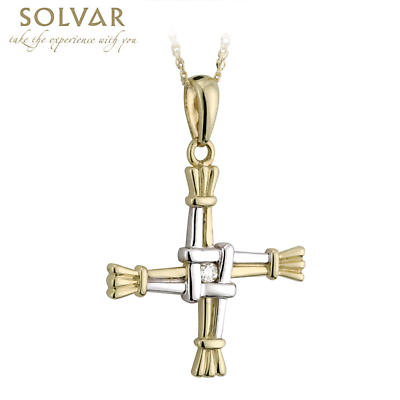St. Brigid’s Day is February 1st. While the day isn’t recognized globally like St. Patrick’s Day, Brigid is Ireland’s other patron saint. In Ireland, her feast day isn’t a public holiday, but it is recognized. School children across Ireland love Brigid’s Day. They get a break from their usual lessons to hear stories about the miracles Brigid performed, color pictures of her and spend much of the day learning to make the distinctive, woven reed cross she designed. St. Brigid’s crosses are hung in many homes in Ireland, and feature in Irish gifts such as pendants. It’s also the first day of spring, so although the weather is usually cold and wet, anticipation of sunnier days hangs in the air.
This cross is to Brigid what the shamrock is to Patrick. It’s a meaningful symbol of Ireland that is used on a range of Irish gifts. And people hang the reed crosses in their homes. Traditionally, people believed that St. Brigid’s crosses would protect a home from harm, particularly from fire, which was a serious concern for people with thatched roofs. In some areas people put the crosses in their kitchens to protect the family from hunger.
Brigid created her unusual square cross while sitting at the bedside of a dying pagan chieftain. History doesn’t clarify, but it might even have been her father. The man was raving and delirious, and his Christian relatives hoped he would convert to Christianity before he died. As she sat vigil by him, she began weaving some of the loose rushes from his floor into a cross. He grew calm watching her, and she began to explain her faith. Legend tells us the man died peacefully having converted to Christianity.
The Life of Ireland’s Other Patron Saint
Legends tell that Brigid had a fascinating life. The daughter of a Druid priest and a Christian mother, she was a strong leader unbowed by male authority figures. She was shrewd, but also deeply compassionate. Brigid founded her famous monastery in County Kildare. It wasn’t smooth sailing for a woman in leadership. But Brigid had plenty of one of the most useful Irish gifts – negotiating skills with a dash of roguery. When she wanted to set up her monastery, she asked the king of Leinster for a bit of land. He refused. She pressed on and asked if she could have just as much land as her cloak would cover. The king was delighted, thinking her a fool. But as she spread her cloak on the ground, it grew and grew to cover acres. The king promptly converted to Christianity, and her monastery in Kildare became very famous. She set up more monasteries around Ireland as well as schools.
Brigid is a busy patron saint. In addition to being of Ireland’s patron saints, she is also the patron of children of single or abused mothers, midwives, dairy and poultry workers, sailors, poets, scholars and printing presses. Ireland’s countryside is dotted with holy wells dedicated to St. Brigid, and she is described as ‘Mary of the Gaels’.

